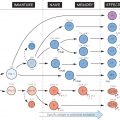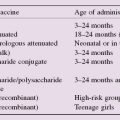It had been evident for many years that T lymphocytes have a surface receptor for antigen, with roughly similar properties to the antibody on B lymphocytes, but furious controversy raged as to whether the two molecules were in fact identical. The T-cell receptor (TCR) was finally identified unambiguously in 1983–4 by the use of monoclonal antibodies to study the fine structure of the molecule and use of DNA probing to identify the corresponding genes.
The TCR has the typical domain structure of an immunoglobulin-family molecule. Its three-dimensional structure is rather similar to that of one arm of an antibody molecule (see Fig. 14), and is made up of two major chains (α, β) each of two domains. A second (γδ) combination is found on some T cells instead of αβ. However, instead of interacting directly with intact macromolecules as does antibody, the TCR recognizes very short stretches of peptide antigen bound to an MHC molecule (as illustrated in the right-hand part of the figure for a T cell of the helper variety). The α and β chains associate on the cell membrane with other transmembrane proteins to form the CD3 complex. This complex, in association with other molecules (e.g. CD4, CD8), is responsible for transducing an activation signal into the T cell.
An unusual feature of the αβ chains of the TCR, which is shared with the heavy and light chain of the antibody molecule, is that the genes for different parts of each polypeptide chain do not lie together on the chromosome, so that unwanted segments of DNA, and subsequently of RNA, have to be excised to bring them together. This process is known as gene rearrangement and occurs only in T and B cells, so that in all other cells the genes remain in their non-functional ‘germline’ configuration. Once this rearrangement has occurred in an individual lymphocyte, that cell is committed to a unique receptor, and therefore a unique antigen-recognizing ability. In this and the following figure, the portions of genes and proteins that are coloured blue are those thought to have evolved from the primitive V region, although they do not all show the same degree of variability.
TCR
The T-cell receptor. It is made up of one α (MW 50 000) and one β (MW 45 000) chain, each with an outer variable domain, an inner constant domain and short intramembrane and cytoplasmic regions. Some T cells, especially early in fetal life and in some organs such as the gut and skin, express the alternative γδ receptor and seem to recognize a different set of antigens including some bacterial glycolipids. γδ T cells are rare in humans, but are a major proportion of T cells in other animals including cows, pigs and sheep. The way in which individual T cells are first positively and then negatively selected in the thymus to ensure they only recognize self-MHC plus a foreign peptide is described in Fig. 16.
CD3
Stay updated, free articles. Join our Telegram channel

Full access? Get Clinical Tree





